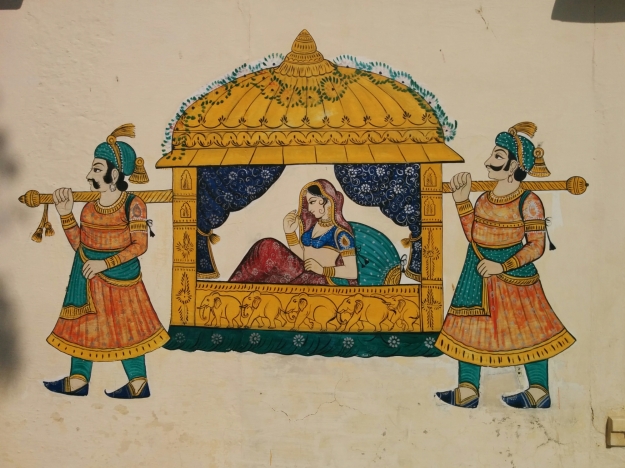“Their main cost is expended upon their women, who ambitiously affect a Gayety in their Dress and Cloathing. Jewels and Ornaments are the very joy of their Hearts….with which they are deckt from the crown of the Head to the very feet. Their Toes are adorn’d with Rings, and their Legs with Shackles of Gold or Silver, or some other Metal, which are sometimes above two Inches in Diameter, wreath’d and hollow. The Women that carry the Water about the Streets, will not walk abroad without these Ornaments upon them. Some tie up the Hair of their Heads, and put it under a hallow large piece of Silver, rais’d somewhat like a Bell, gilt and neatly embellisht on the outside, and fasten’d to the Crown of their Heads. Some wear Earrings all round their Ears, which for Ornament’s sake will dangle sometimes almost down to their Shoulders, and have Bracelets about their Necks and Arms, and Rings about their Wrists, and on every Finger. Some adorn themselves with Breast Jewels, form’d in Fashion of a Heart, compos’d of variety of Diamonds, Rubies, Saphiers and other Stones of Esteem; and on their Fore-heads wear a Gold Bodkin, broad at the end, beset with glittering Diamonds, or some other precious stones. And as they are much taken with this gaudy Attire, and delight in these splendid Ornaments themselves, so they think them a kindness to the very Brutes; and shew their Affection to a Darling Cow, or Favourite Goat, by fastening large Rings of some Metal or other about their Legs. Nor will they spare their Ornamental Favours to the Fruit trees of their Gardens, but shew them their profuse Respect in adoring them with Painting of divers Colours.
-J Ovington, A Voyage to Surat in the year 1689
In my hindi lesson the other day, my hindi teacher told me that there is a separate word in Hindi for golden jewelry. It turns out that my hindi teacher was completely wrong about this, as she often is, which is a story for another day, but the truth is, I don’t exactly blame her for associating gold with jewelry to the point that she conflated the two. The word she used, which literally means ornament, doesn’t have an association with gold, but jewelry in India totally does.
Now, obviously you can find jewelry of all kinds here, and you will, if that’s what you want, gems from Jaipur, diamonds from the Deccan Plateau, pearls from the coast, silver from Gujurat, copper and brass from mining towns, and beads from every direction and out of every material. But gold is king. Everyone everywhere has a bit of it, from a thin bangle or miniscule nose stud on a woman of modest means, to a multi-piece set that looks like a suit of armor for a bride at her wedding (because nothing says my special day like being weighed down by 20 pounds of jewelry).
Based on what scholars can find out about the bronze age settlements in this region, people have been wearing gold jewelry in India for over 4000 years. Gold is mentioned in both major Indian epics, specifically gold jewelry, which implies that even mythical heroes knew how to treat themselves. Gold is considered auspicious in India, and it’s seen as an excellent very mobile investment. It’s been woven into Indian religious traditions to such a degree that you have to wonder if Bramihnical priests of the Indus River Valley had some kind of deal set up with the goldsmiths. Gold is given at religious holidays, both s offerings to the idols and as gifts between family and friends. Many idols are dressed in garments made of gold, or at the very least adorned with jewelry made of the stuff. It’s considered an essential at weddings, so God(s) help the bride who looks better in silver. Gold is the symbol of Lakshmi, the goddess of wealth. In fact, gold is the symbol of wealth, period. The wealthier the person, the more gold they are expected to buy and wear. You can mortgage gold in India, you can get a gold specific loan, and no one blinks an eye when fathers complain about the massive amounts of spending they do to get their daughters wedding-ready. If you don’t go broke hosting a wedding, do you even love your child? IS A REAL QUESTION PEOPLE ASK.
None of this is all that surprising, right? I mean, this is gold we are talking about. India isn’t the only country that prized gold historical. Which other countries, you might ask? Why, ALL OF THEM, of course! Humanity’s obsession with gold, a shiny soft metal with very few practical uses, is well documented in every museum and history book under the sun. Every culture has found ways of ornamentation and decoration with shiny things, but I know few aesthetic traditions that value the maximalism (thank you a thousand times, Arti Sandhu, for the term that I literally think about DAILY in my life here) to the extent that India does.
Going to an event here, specifically a wedding, one would think that the dress code had specified “wear all the jewelry you own”. The jewelry I wore for my own Indian wedding was the heaviest, largest, most gold set of things I have ever put on my body, and many people would say that as wedding jewelry goes, it was pretty, well, not minimal, but we could have gone much bigger with the look. As they say. And if you don’t believe me based on my photo, you can check out this article which details how, exactly, an Indian bride is supposed to be adorned. Here is a hint the number of adornments you are supposed to wear matches the age at which you can get your driver’s license in the United States.
n a country where dowries are still very much a part of the marriage process for many people, despite their illegality,gold is the one thing you can be sure will be accepted anywhere. Of course, gold mania cuts both ways, with grooms and their families demanding outrageous sums and “dowry deaths” (brides killed in retaliation for a lower dowry than expected or promised) are far from a thing of the past. To me, as a non-Indian spectator, this calls into question the whole concept of gold’s auspicious nature. At what point does what we value become all that we can see?
From a western perspective, especially if yours is an aesthetic verging towards minimalism, Indian jewelry is extremely overwhelming. How did it happen, I wonder, that minimalism arose as a design concept and why was India left out of that movement? It might have to do with polarization of wealth and concepts of conspicuous consumption, although it is worth noting that not ever Indian community has an equivalent “more is more” philosophy. For example, the Konkani guests, dressing in their sensible shoes and simple, elegant outfits, at each of our wedding functions watched, amused, as Punjabi women in vivid hues of georgette silks glittering with gems and metals, real or fake, tottered around on high heels. Certain groups of South Indians, I have heard, have simple daytime affairs in which they invite close family and bling’s invitation gets lost in the mail.
But by and large, as I walk around Mumbai, the women (and some men) glitter day and night. It is amazing, though, how time and familiarity changes your opinion. When first encountering this level of bling, I found it overwhelming, aesthetically challenging, and hard to see without longing for sunglasses. But as time has gone by, the shine has become prettier in my eyes, or at least, more bearable. Looking at women coated in gold no longer surprises me. I guess when you see so much gold every day, in little pieces and big ones, it just becomes normal. Who knows? Perhaps soon enough I, too, will have gold for every occasion. How I long for the day when I can trade my daytime gold for nighttime gold. A girl can dream….

There is something so amazing and jarring about the juxtaposition of 1950’s hair and make-up and the jewelry.




